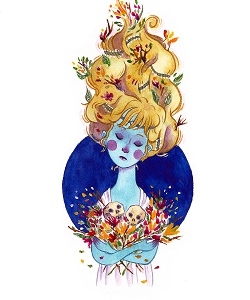MM: How do you first come up with a concept for an illustration?
JC: I don’t really have just a single process, sometimes a sentence is enough to give me a whole idea for a new illustration, and sometimes it’s after hours of trying to work something out.
MM: Where do you get your inspiration?
JC: Usually from music, it’s amazing what music can do to your imagination when you are low on ideas. I also like to work from everyday moments and situations which can be very charming. Tumblr is also is a huge source of ideas.
MM: Do you feel that illustration always has to respond to other sources like literature, journalism, music…?
JC: I don’t know if it has to, but I think it’s what usually works for most of the illustrators, since it can be the beginning of a whole creative process; find the right sentence, read some book that touches you, a song that makes you want to sing… at least in my process, I work better from something that inspires me rather than just trying to get an idea out of nothing, from a blank page.
MM: What qualities do you think are important to set the work of one illustrator apart from the others?
JC: It’s important to know what you want to share with the public through the illustrations, to communicate a clear idea. Sometimes we get frustrated with the concept of getting our own style I suppose, but I have come to realize that it happens by itself if you work hard, if you are persistent and if you are able to imprint your character on your work. And even when you think you have reached a certain personal style, it keeps changing though the years with the new influences you have, but it still always has that essence that will allow others to recognize your illustrations.
MM: In your work you combine both digital and traditional techniques, do you have a preference? Why? How do you chose to apply each, is it a matter of concept or convenience?
JC: I certainly prefer traditional techniques, as I feel that they give the illustration a certain warmth. That doesn’t mean that digital work can’t also look warm— since I usually end up modifying little things with digital techniques anyway— but I just like traditional work better.
MM: With regards to choosing which technique to apply – digital or traditional – it’s very important to be realistic about the amount of time that you are given to do the work. So yes, sometimes it ends up being more a matter of convenience than anything else.
JC: Even so, I like to sketch out the first ideas digitally as sometimes unexpected accidents happen and what I was sure was going to be done with watercolors ends up looking better done on the computer. So it’s very important to keep an open mind, to consider all the options.
MM: What influence do you think the different techniques, traditional or digital, have on the final result?
JC: It depends on the culture or the country. There are some countries that for example prefer to work with more traditional techniques, usually because of the more classic, old-school feeling that these add to the work, while others prefer a more modern, minimalist approach so they tend to work more digitally. But in the end it doesn’t really matter all that much since the technology nowadays allows such a huge range of possibilities. You can often find work that appears to be traditional and then you discover it was done a hundred per cent digitally.
MM: As a whole, how do you feel that technology has affected illustration in the last decade?
JC: I think it has been a great way to innovate, to break barriers that were impossible to break before, to embrace new concepts of illustration. The art and design programs improve every day and each software application provides infinite combinations and ways of painting so you will never run out of experiments that can be done.
MM: With the internet and e-books threatening to diminish the print industry, how do you see it affecting illustration?
JC: I see it affecting illustration in a bad way only if we are not able to adapt fast enough. Being afraid of the modern technologies won’t make the internet and e-books disappear, so we have to think differently to be able to apply our art to a new medium. In this new internet era lots of people from all over the world can see your work. It’s true that they can also see the work of eight hundred other illustrators, but that doesn’t mean the chances of getting a job are getting thinner, it means that there are more people who can make their projects public and maybe you will fit into one of them, you just have to be patient and not become discouraged by the rejections.
MM: So the internet is actually a very effective way of promoting your work?
JC: If you know how to do it and you are an active person, it clearly is an effective way to promote your work. In fact nowadays it’s almost impossible to become well known without a site on the net, you need to be seen and be able to show your portfolio online. To exchange your illustrations and get to know new people with new ideas that make you want to paint more.











